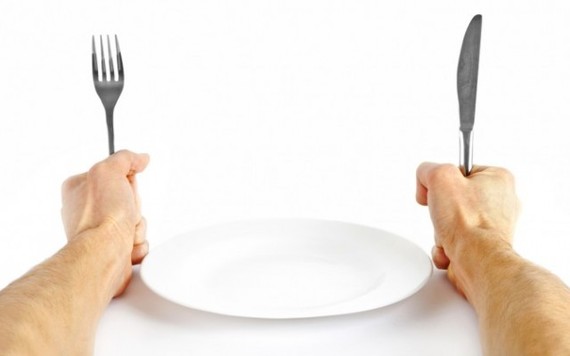Today I'll focus on the most common reason diets fail: hunger.
Diets make you hungry. Diets deprive. They rob you of the sweet, the treat, the soothing and the substitute. As Mick Jagger would put it, you can't get no satisfaction.
To begin at the beginning, we must put certain persistent myths to rest.
All Calories Were Created Equal or Calories In/Calories Out
This credo goes as follows. A calorie is a calorie is a calorie. Whatever form it comes in, how it's absorbed, when you eat it, the types of bacteria in your gut, what meds you take, your age and gender and muscle mass... it's all the same. Just take in less and burn more and you're good to go. Seems logical, but afraid not.
When you eat less the body adapts to this change in energy balance by slowing metabolism, moving less and feeling very hungry. A short-term weight loss may occur but cannot be sustained. Our bodies have a sort of famine fail-safe system that kicks in after about 7% of our weight is lost.
This has been demonstrated by underfeeding both lean and obese subjects. A short-term weight loss of 10-20% led to a commensurate decrease in energy expenditure. Metabolism slows and hunger increases dramatically in an effort to protect a baseline body weight. Diet fails.
We often forget that we eat to obtain fuel. Because survival required this energy intake, evolution endowed us with a highly regulated system for monitoring our fuel tank (glycogen and fat storage). Hunger is a biological signal that we are low on fuel.
Both low and high fuel levels generate powerful messages that direct our behavior toward or away from food. For example eating when hungry generates more dopamine, making it more rewarding than when we're full. Modern life (sedentary lifestyle and processed highly caloric food) has broken this internal fuel gauge. Weight control is impossible without it.
Insulin, an anabolic hormone, plays a key role in body weight regulation. After eating it shunts glucose and fat into storage. Insulin signals the brain that the fuel tank is full and silences the hunger message. This works well with a healthy diet and adequate physical activity.
Here's the catch. High glycemic index (GI) foods fool the fuel gauge. By causing a rapid spike in blood glucose the body overproduces insulin. The high insulin levels quickly store the glucose making it seem as if we haven't fed. Now metabolism goes into a energy hoarding mode. Even without an increase in caloric intake, weight gain can occur. For a quick review of GI go to the end of this article.
It gets worse. When subjects on a high GI diet cut calories in an effort to lose weight they still gain more fat (70%) than those on a low glycemic diet. And they get hungrier. High insulin levels shuttle the energy into storage. Metabolism slows in an attempt to compensate for the decrease in circulating fuels.
In other words, if you're eating the wrong foods you can continuously gain fat without taking in more calories. And high GI foods will make you eat more. In fooling our fuel gauge, high GI diets don't allow the satiety (I'm full) message through. So the hunger signal persists and we continue to eat despite adequate energy levels. Those extra calories go into that energy depot around your waist, belly jelly A.K.A. fat.
So think less about calories and more about the kind of food you eat. Fast food is fast. It raises blood glucose levels quickly, i.e. high GI. We want slow carbs in order to keep your insulin levels low.
Some foods are better at making you feel full than others. Lean protein fills you faster than fat and for longer than carbohydrate. It also increases your metabolic rate for as long as two and a half hours after eating. High volume foods also induce satiety. Soup, vegetables and salad fill up the stomach stimulating stretch receptors that signal the brain it's time to stop eating. And lastly, slow down. By eating slowly the full signal can take effect and cut off over eating. Eating slow foods, high fiber foods, also promotes satiety.
Slowing down also means acknowledging that we all are stressed and need to do something about it. Stress increases cortisol levels, a hormone secreted in the adrenal gland. Cortisol promotes the desire for fatty sweet foods. Unfortunately, such comfort foods do temporarily relieve stress and are therefore addictive.
Here are some simple strategies to quell hunger cravings and allow a sustainable diet.
Steps to Reduce Insulin Levels and Stop The Hunger Signal
•Know the GI of foods and go low
Eat: whole grains, nuts, legumes, fruits and vegetables without starch
Limit: potatoes, white rice, breads
Don't eat: white bread, sugary foods, including candy, cookies, cakes, and sweet drinks
•Lower your carbohydrate intake
Eat more vegetables (let them be your primary source of carb) and less bread, potato, pasta, rice
•Eliminate added sugar
•Don't be afraid of fats
Eat: olive oil, fatty fish such as salmon, mackerel, herring and trout.
Limit: fatty meats and dairy
Don't eat: transfats
•Eat lean protein: skinless chicken, fish, lean pork and beef
•Have a glass of water before every meal, increase fiber and address stress. There is no one size fits all. Find what works for you.
Glycemic Index
High glycemic index (GI) diets cause a rapid increase in blood glucose levels. This triggers a surge in insulin secretion and a consequent excessive fat storage.
The glycemic index scale runs from 0-100. The smaller the number, the less impact the food has on your blood sugar.
•55 or less = Low (good)
•56- 69 = Medium
•70 or higher = High (bad)
Food labels should provide the GI. Several on-line references are available for checking the GI of foods.
